 This site is not less than 200 years old and includes about forty monuments including the largest open-air bas-relief in the world. Mahabalipuram or the City of Bali is also known as Mamallapuram, is a temple town situated along the shores of the Bay of Bengal about 60 kms from the south Indian city of Chennai. It has various historic monuments built largely between the 7th and the 9th century. It is named after Mamalla, who was responsible of creating the earliest monument in the city under the reign of the Pallava king Narasimha Varman I (630-668). This site gained this distinction in 1984 and is known best as the centre for culture and arts of Pallavas. This group of sanctuaries was carved out of rock along the Coromandel Coast in the 7th and 8th centuries.
This site is not less than 200 years old and includes about forty monuments including the largest open-air bas-relief in the world. Mahabalipuram or the City of Bali is also known as Mamallapuram, is a temple town situated along the shores of the Bay of Bengal about 60 kms from the south Indian city of Chennai. It has various historic monuments built largely between the 7th and the 9th century. It is named after Mamalla, who was responsible of creating the earliest monument in the city under the reign of the Pallava king Narasimha Varman I (630-668). This site gained this distinction in 1984 and is known best as the centre for culture and arts of Pallavas. This group of sanctuaries was carved out of rock along the Coromandel Coast in the 7th and 8th centuries.
History
This temple town is said to be at least two thousand years old and boasts of about forty monuments; for its rathas (temples in the form of chariots), 11 excavated temples or mandapas (cave sanctuaries), giant open-air relief such as the famous `Descent of the Ganges` and `Arjuna`s Penance` and the temple of Rivage, with thousands of sculptures to the glory of Shiva. These monuments are mostly rock-cut and monolithic, and constitute the early stages of Dravidian architecture wherein Buddhist elements of design are prominently visible.
This centre of pilgrimage for centuries has an atomic power plant as its neighbor. Besides this, there are several famous temples at Mahabalipuram, where the Temple of Sthalasayana Perumal and the Shore Temple are perhaps the best of all. It is believed by some that this area served as a school for young sculptors. The different sculptures, some half finished, may have been examples of different styles of architecture. This can be seen in the Pancha Rathas where each Ratha is sculpted in a different style. Since the 7th century, when Mahabalipuram was made a seaport by Mamalla, the rock-cut temples have become quite popular here. The `Tigers Cave` is quite popular among the tourists too.
Site & Architecture
 Shore Temple: The Shore Temple at Mahabalipuram, a coastal village 50 km south of Madras, was built in the 7th century, during the reign of Rajasimha, and they depict the final flowering of Pallava art. This is a structural temple along the Bay of Bengal with the entrance from the western side away from the sea. The beauty of the rock-cut sculpture of the temple is reflective of the artistic tastes of the erstwhile Pallava rulers. These temples are refreshingly uncluttered, unlike later grandiose Dravidian architecture and tower over the waves behind a protective breakwater. The temple with its beautiful polygonal dome enshrines Lord Vishnu and Shiva. UNESCO has declared these beautiful temples, ravaged by wind and sea world heritage. Recent excavations have revealed new structures here. The temple was reconstructed stone by stone from the sea after being washed away in a cyclone.
Shore Temple: The Shore Temple at Mahabalipuram, a coastal village 50 km south of Madras, was built in the 7th century, during the reign of Rajasimha, and they depict the final flowering of Pallava art. This is a structural temple along the Bay of Bengal with the entrance from the western side away from the sea. The beauty of the rock-cut sculpture of the temple is reflective of the artistic tastes of the erstwhile Pallava rulers. These temples are refreshingly uncluttered, unlike later grandiose Dravidian architecture and tower over the waves behind a protective breakwater. The temple with its beautiful polygonal dome enshrines Lord Vishnu and Shiva. UNESCO has declared these beautiful temples, ravaged by wind and sea world heritage. Recent excavations have revealed new structures here. The temple was reconstructed stone by stone from the sea after being washed away in a cyclone.
`Ratha` Cave Temple: The Pallava king Narsimha built the magnificent `Ratha` cave temples of Mahabalipuram in the 7th and 8th centuries. There are eight rathas at Mahabalipuram, out of which five are named after the `Pandavas` of Mahabharata and one after Draupadi. The five rathas (five monolithic pyramidal structures) that can be seen are Dharmaraja Ratha, Bhima Ratha, Arjuna Ratha, Draupadi Ratha and Nakul Sahadev Ratha.
They are constructed on the style of the Buddhist viharas and chaityas. The unfinished three-storey Dharmaraja ratha is the largest. The Draupadi ratha is the smallest; it is one-storeyed and has an interesting thatch-like roof. The Arjuna and Draupadi rathas are dedicated to Shiva and Durga respectively. The `rathas` in the south of these monuments are along with three big sculptures of a Nandi, a Lion and an Elephant. An interesting aspect of the rathas is that, despite their sizes they are not assembled - each of these is carved from one single large piece of stone.
Due to the 2004 Indian Ocean earthquake, many other carvings were also revealed; various rocky structures and carvings of animals, which included an elaborately carved head of an elephant and a horse in flight. A small square-shaped niche with a carved statue of a deity could also be seen above the head of the elephant. In another structure, there was a sculpture of a reclining lion. The use of these animal sculptures as decorations is consistent with other decorated walls and temples from the Pallava period in the 7th and 8th centuries.
Many British travelers also give an account of the seven pagodas by the sea near the area of Mahabalipuram. This account was first written down by John Goldingham who was told of the "Seven Pagodas" when he visited in 1798. These structures were considered to be a part of the legendary pagodas and the Archaeological Survey of India has also sent divers to begin underwater excavations of the area on February 17, 2005.



















